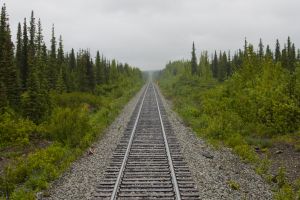This page is a work in progress - do not use as a reference
Railroad 

The |-|-|-|-|-|-|-|-|-| Railroad |-|-|-|-|-|-|-|-|-| road type serves three purposes in Waze. First, it provides drivers with visual orientation relative to railroad and light-rail tracks. More importantly, in the common case where passenger-carrying tracks lie parallel with roads, mapping the tracks allows Waze to recognize spurious speed data from people Wazing on the train and prevent it from corrupting speed data for the adjacent road. Finally, when a railroad crosses a drivable road segment at grade (same elevation) the routing server can better determine delays at that crossing.
The guidelines below which allow junctioning of railroads to drivable segments is new as of October 24, 2014.
|
As of July 2015[update] the automated Map Problem search algorithm will identify suspected errors at railroad crossings. It is common to see the “restricted turn might be allowed” error where a railroad crosses a drivable segment nearby to where another drivable segment also crosses. These kinds of map error should be marked as “Not Identified” so that they are not shown again at that location. Do not enable turns at railroad crossings.
Use the following guidelines when mapping railroad segments:
- By default, enter "Railroad" for the street name of every railroad segment. (See more below on Naming railroad segments.)
- Always select "None" for the city name. This avoids city smudging.
- Lock the segment at L2.
- Do not map railroads below ground, as they do not serve any of the three purposes outlined above. This is especially true in urban areas where underground rail lines are common, and their appearance on the map would be confusing to drivers.
- Set the elevation just as you would a drivable segment. When tracks junction a road on the ground, the Elevation should be set to Ground.
- Create junctions between drivable roads and railroads.[rr]
- Set railroad to 2-way directionality
- Restrict turns to and from the railroad segments.
- When mapping railroad tracks, focus on those near drivable roads.
- Map rail yards simply, with one railroad segment along either edge of the yard's tracks.
- Map industrial spurs only if they cross drivable roads.
- Do not map every piece of parallel track, such as in sidings or yards, or industrial spurs that don't cross any roads. Your work may otherwise be seen as clutter, much like mapping every parking lot row.
- Multiple parallel lines at crossings:
- At most crossings, there should be only one railroad segment mapped and no more than two parallel railroads mapped at any crossing.
- Parallel lines are to be at least 5m apart
- In general, there is no reason to have multiple lines mapped. When not at a crossing, even four parallel lines can be easily mapped as a single railroad segment in Waze.
- Keep segment lengths under 10,000 meters – the longer the segment length, the more sluggish the editor is to respond to changes.
- Do not map railroads using a drivable road type (streets, primary streets, etc.); it could be a hazard to human life if drivers were routed to them.
^rr Note: The routing server will properly account for delays at railroad crossings through a segment without a junction. However, with a junction, the historical data for the rail crossing will be more accurate.
Use the following guidelines when naming railroad segments:
- For commercially-controlled right-of-ways, rather than apply the default "Railroad" name, you may optionally use the owner's full legal name spelled out without acronyms or abbreviations (e.g. "New Orleans Public Belt Railroad"). Some owners' names incorporate what appear to be or once were acronyms but are actually part of the legal name (e.g., "BNSF Railway", "CSX Railroad").
- In case of uncertain ownership, do not guess. Use the default "Railroad" name.
- Do not name a railroad segment for a passenger operator that uses it, regardless of how many passengers or how little freight it may carry, unless you are absolutely certain that the passenger operator owns the track. For example, do not name a segment "Amtrak" unless Amtrak actually owns the track (it usually does not, except in the Corridor and in a few other areas).
- Do not apply "fallen flags" (former owners that no longer exist due to bankruptcy or merger) in the alternate field.
- Keep in mind that should the name of the owner change, due to bankruptcy, merger, or other business decision, you or another editor will need to come back and fix all now-incorrect segments. Railroads can change names often; for example, BNSF Railway has been known by that name only since 2005, and its previous name was in use for only eight years.
- For urban rapid transit and light rail systems, rather than apply the default "Railroad" name, you may optionally use the name of the transit authority and the name of the line, separated by a hyphen (e.g., "MBTA - Green Line", "RTA - Riverfront Streetcar").
- If a system has only one line, of course, use its name alone (e.g., "Detroit People Mover").
- If multiple lines share the same track or run on parallel tracks, include all lines (e.g., "Metro Rail - Red/Purple Lines").
- However, if a rapid transit system is so complex that including all line names would lead to an absurd result on some railroad segments, use the name of the system alone (e.g., "BART", "MTA") throughout the system.
- Federal DOT Railroad GIS: http://fragis.fra.dot.gov/Apps/GISFRASafety/
Waze - Support
Railroads should be labeled as such in the editor. For the time being they won't make it to the client indeed, but in the future we might want to use them for display purposes.
The "railroad" road type in the editor is under "non drivable" so it should not cause any issue to the routing.
For specific recommendations in other countries outside the United States, please see the entry for the country in question here.